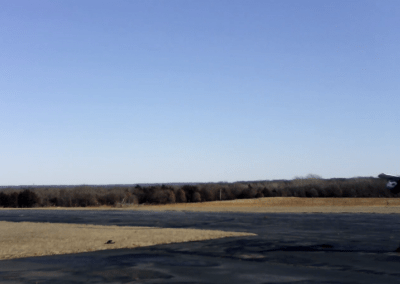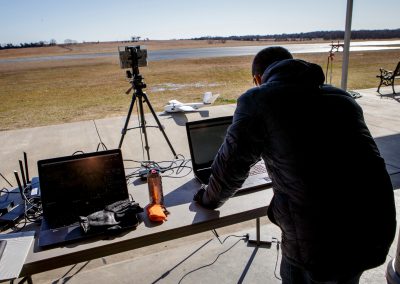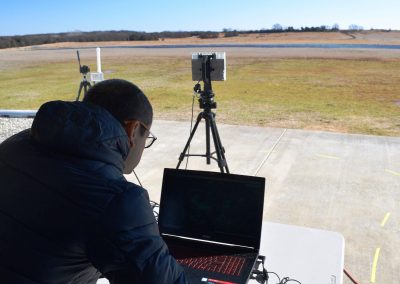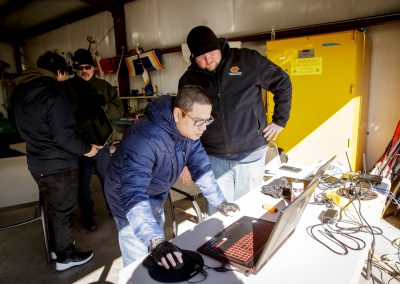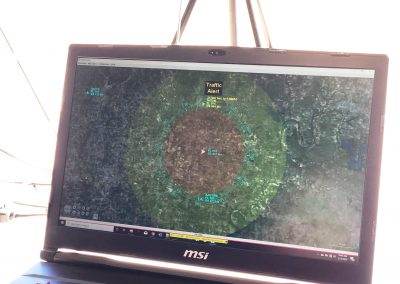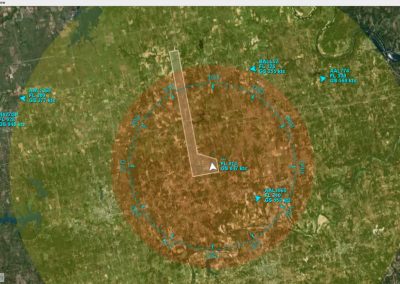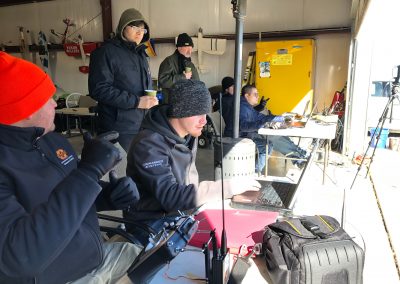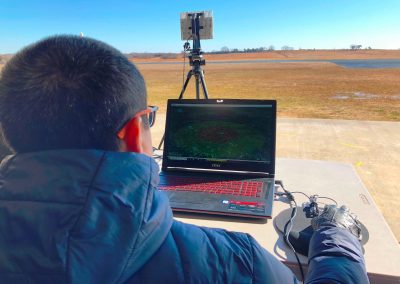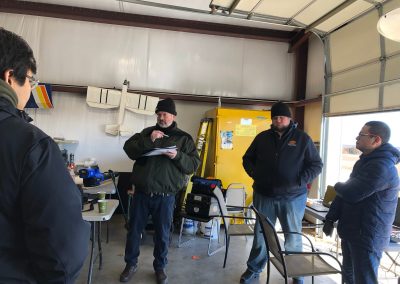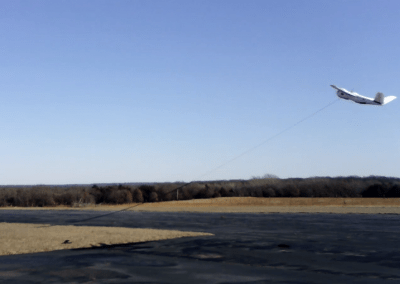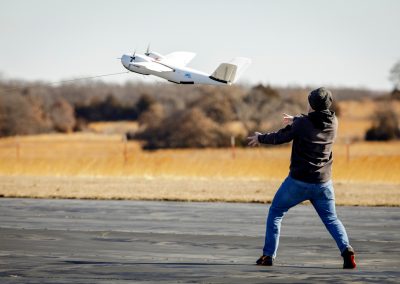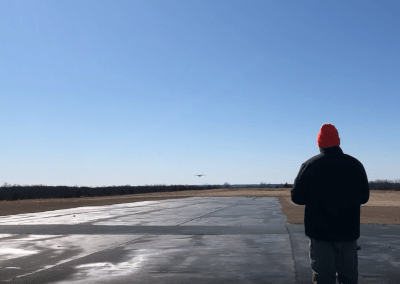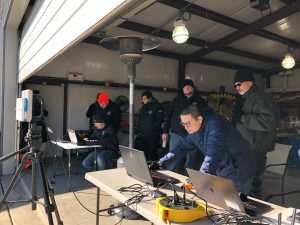
The research and flight testing team from OSU and Vigilant Aerospace review systems during the recent flight at the OSU Unmanned Aircraft Flight Station.
Technical Milestones
The recent flight test achieved several important milestones in the development and testing of the FlightHorizon safety system. The latest version of the software fuses data from multiple sources to create a complete view of air traffic. During the flight test, the system combined data from both manned aircraft transponders (ADS-B) and from drone radio telemetry. FlightHorizon is currently compatible with a wide range of transponder radio receivers, including the uAvionix PingStation, and with any of the hundreds of models of drone flight controllers that use the popular MavLINK protocol.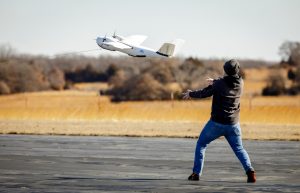
OSU twin-motor, fixed-wing UAS taking off from the OSU Unmanned Aircraft Flight Station on Feb. 13, 2020
Photo Credit: Gary Lawson/Oklahoma State University
Future Flights and Development
The research and development team is looking forward to the next round of test flights in April and May, 2020. “In the future, we eagerly anticipate both having radar tracking directly in the FlightHorizon system and also the demonstration of distributed installations across multiple computers, fusing data from sensors at multiple locations,” said Epperson.About the OSU Unmanned Systems Research Institute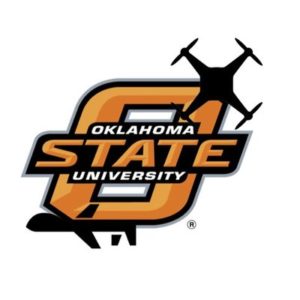
From the website:
Unmanned vehicles have become a revolutionary technology that is taking the world by storm. The OSU Unmanned Systems Research Institute (USRI) accesses expertise across Oklahoma State University allowing them to combine cutting edge product development with academic knowledge and resources to create unique solutions to critical problems. For more information on the OSU Unmanned Systems Research Institute, visit CEAT.okstate.edu/USRI.
About the OSU School of Mechanical and Aerospace Engineering
From the website:
The Oklahoma State University School (OSU) of Mechanical and Aerospace Engineering (MAE) instructs and encourages students to reach full potential in technical expertise, innovative expression, intellectual curiosity, and collaborative design. MAE’s mission is to prepare engineers that are competitive nation-wide and internationally for employment opportunities and who will become respected achievers within their discipline and prepared for a lifetime of continuing development. For more information on the OSU School of Mechanical and Aerospace Engineering, visit MAE.okstate.edu.
About the Oklahoma Center for the Advancement of Science & Technology (OCAST)
From the website: The Oklahoma Center for the Advancement of Science and Technology (OCAST) was established in 1987 by the Oklahoma legislature for the purpose of growing and diversifying the state’s economy through technology development, technology transfer and technology commercialization. OCAST’s was founded with the purpose of expanding and diversifying Oklahoma’s economy and providing new and higher quality jobs for Oklahomans by encouraging the development of new products. OCAST also is an active supporter of STEM education across Oklahoma’s common education system and provides funding to support internships between local industries and higher education. For more information on OCAST, visit www.OK.gov/OCAST
The Oklahoma Center for the Advancement of Science and Technology (OCAST) was established in 1987 by the Oklahoma legislature for the purpose of growing and diversifying the state’s economy through technology development, technology transfer and technology commercialization. OCAST’s was founded with the purpose of expanding and diversifying Oklahoma’s economy and providing new and higher quality jobs for Oklahomans by encouraging the development of new products. OCAST also is an active supporter of STEM education across Oklahoma’s common education system and provides funding to support internships between local industries and higher education. For more information on OCAST, visit www.OK.gov/OCAST
About Oklahoma Applied Research Support (OARS)
The Oklahoma Applied Research Support (OARS) program is an OCAST funding program that invests in research and development supporting innovative technologies with commercial potential. This funding is designed to increase investment in the R&D of new technologies that will ultimately bring value to the state of Oklahoma and help grow and diversify the state’s economy. Oklahoma public or private colleges/universities, non-profit research institutions, and private enterprises with the principal place of business in Oklahoma are all eligible to apply for OARS funding. To learn more about OARS, visit the program website.
About Vigilant Aerospace Systems
Vigilant Aerospace Systems is a private company headquartered in Oklahoma City, Oklahoma providing software and services worldwide. In addition to the FlightHorizon system, the company also provides integration and development consulting, testing, training and compliance services for unmanned aircraft flight operations and fleet managers. For more information on Vigilant Aerospace Systems and FlightHorizon detect-and-avoid and airspace management system, visit our website at www.VigilantAerospace.com
About FlightHorizon
FlightHorizon is a situational awareness and safety system for airspace management. The system provides airspace managers with either a 2D or 3D view of all aircraft in the selected airspace using a combination of sensors and data sources to create an airspace safety picture for pilots, airspace managers and command centers.
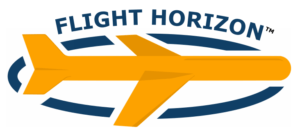 The system is based on an exclusively licensed NASA patent and prototype that has been used in extensive flight testing, including beyond visual line-of-sight (BVLOS) flight testing at NASA Armstrong Flight Research Center and at the OSU Unmanned Aircraft Flight Station.
The system is based on an exclusively licensed NASA patent and prototype that has been used in extensive flight testing, including beyond visual line-of-sight (BVLOS) flight testing at NASA Armstrong Flight Research Center and at the OSU Unmanned Aircraft Flight Station.
FlightHorizon functions as both a visualization tool for airspace management, an active situational awareness tool and as a detect-and-avoid system that enables unmanned aircraft to avoid other aircraft and keeps drone pilots and airspace managers aware of the location and air traffic around their UAS and in their airspace. The system provides the ability to designate one or more aircraft as “ownship” and to track those aircraft specifically for collision avoidance and provides self-separation advisories for those aircraft, including visual cues, on-screen text warnings and audible advisories. FlightHorizon is also designed to help users to better meet civil aviation authority regulations and requirements and to reduce risk. It can also improve the relative competitiveness of subscribing airparks in attracting UAS operators and service providers. For more information on FlightHorizon, visit our Products and Services page.
Flight Test Photos:
2020.02.13_09 – Flight Test with OSU
OSU twin-motor, fixed-wing UAS taking off from the OSU Unmanned Aircraft Flight Station on Feb. 13, 2020.
200213_usri_test_flight_007-2048x1252_300dpi
Vigilant Aerospace System’s team setting up FlightHorizon with an EchoGuard radar unit at the OSU Unmanned Aircraft Flight Station.
Photo Credit: Gary Lawson/Oklahoma State University
2020.02.13_01 – Flight Test with OSU_2048x1152px
Vigilant Aerospace System’s team setting up FlightHorizon with an EchoGuard radar unit at the OSU Unmanned Aircraft Flight Station.
200213_usri_test_flight_011-2048px_300dpi
The OSU and VAS team setting up for the flight at the OSU Unmanned Aircraft Flight Station.
Photo Credit: Gary Lawson/Oklahoma State University
2020.02.13_02 – Flight Test with OSU_2048x1524px
FlightHorizon displaying airspace traffic data while tracking ownship.
2020.02.13_03 – Flight Test with OSU_2048x1536px
Vigilant Aerospace Systems setting up FlightHorizon with Oklahoma State University setting up the radar display.
2020.02.13_08 – Flight Test with OSU_FlightHorizon screen_1700x833px
Airspace display capture from FlightHorizon during the flight demonstration on Feb. 13, 2020
2020.02.13_06 – Flight Test with OSU_2048x1536px
The OSU and VAS team actively monitoring the flight from the OSU Unmanned Aircraft Flight Station
2020.02.13_04 – Flight Test with OSU_2048x1536px
Vigilant Aerospace System’s team monitoring the UAS flight with FlightHorizon at the OSU Unmanned Aircraft Flight Station.
2020.02.13_07 – Flight Test with OSU_2048x1536px
Vigilant Aerospace Systems’ CEO Kraettli Epperson debriefing the team after a successful flight demonstration.
2020.02.13_11 – Flight Test with OSU-takeoff
OSU twin-motor, fixed-wing UAS taking off from the OSU Unmanned Aircraft Flight Station on Feb. 13, 2020
200213_usri_test_flight_028-2048px_300dpi
OSU twin-motor, fixed-wing UAS taking off from the OSU Unmanned Aircraft Flight Station on Feb. 13, 2020
Photo Credit: Gary Lawson/Oklahoma State University
Media Coverage:
- “OSU partnership with Vigilant Aerospace powered by NASA technology.” Oklahoma State University; 25 February 2020.
- “BVLOS tests boosted by Oklahoma Center support grant.” Unmanned Airspace; 27 February 2020.
- “OSU, Vigilant working to help drones ‘talk’.” Journal Record; 26 February 2020. [Subscription Required]
- “OSU Partnership with Vigilant Aerospace Powered by NASA Technology.” 26 February 2020.
- “Partnership powers by technology.” The Ponca City News; 27 February 2020. [Subscription Required]

